Zhenkai Liang
RSafe: Incentivizing proactive reasoning to build robust and adaptive LLM safeguards
Jun 09, 2025Abstract:Large Language Models (LLMs) continue to exhibit vulnerabilities despite deliberate safety alignment efforts, posing significant risks to users and society. To safeguard against the risk of policy-violating content, system-level moderation via external guard models-designed to monitor LLM inputs and outputs and block potentially harmful content-has emerged as a prevalent mitigation strategy. Existing approaches of training guard models rely heavily on extensive human curated datasets and struggle with out-of-distribution threats, such as emerging harmful categories or jailbreak attacks. To address these limitations, we propose RSafe, an adaptive reasoning-based safeguard that conducts guided safety reasoning to provide robust protection within the scope of specified safety policies. RSafe operates in two stages: 1) guided reasoning, where it analyzes safety risks of input content through policy-guided step-by-step reasoning, and 2) reinforced alignment, where rule-based RL optimizes its reasoning paths to align with accurate safety prediction. This two-stage training paradigm enables RSafe to internalize safety principles to generalize safety protection capability over unseen or adversarial safety violation scenarios. During inference, RSafe accepts user-specified safety policies to provide enhanced safeguards tailored to specific safety requirements.
AlphaSteer: Learning Refusal Steering with Principled Null-Space Constraint
Jun 08, 2025Abstract:As LLMs are increasingly deployed in real-world applications, ensuring their ability to refuse malicious prompts, especially jailbreak attacks, is essential for safe and reliable use. Recently, activation steering has emerged as an effective approach for enhancing LLM safety by adding a refusal direction vector to internal activations of LLMs during inference, which will further induce the refusal behaviors of LLMs. However, indiscriminately applying activation steering fundamentally suffers from the trade-off between safety and utility, since the same steering vector can also lead to over-refusal and degraded performance on benign prompts. Although prior efforts, such as vector calibration and conditional steering, have attempted to mitigate this trade-off, their lack of theoretical grounding limits their robustness and effectiveness. To better address the trade-off between safety and utility, we present a theoretically grounded and empirically effective activation steering method called AlphaSteer. Specifically, it considers activation steering as a learnable process with two principled learning objectives: utility preservation and safety enhancement. For utility preservation, it learns to construct a nearly zero vector for steering benign data, with the null-space constraints. For safety enhancement, it learns to construct a refusal direction vector for steering malicious data, with the help of linear regression. Experiments across multiple jailbreak attacks and utility benchmarks demonstrate the effectiveness of AlphaSteer, which significantly improves the safety of LLMs without compromising general capabilities. Our codes are available at https://github.com/AlphaLab-USTC/AlphaSteer.
OSS-Bench: Benchmark Generator for Coding LLMs
May 18, 2025Abstract:In light of the rapid adoption of AI coding assistants, LLM-assisted development has become increasingly prevalent, creating an urgent need for robust evaluation of generated code quality. Existing benchmarks often require extensive manual effort to create static datasets, rely on indirect or insufficiently challenging tasks, depend on non-scalable ground truth, or neglect critical low-level security evaluations, particularly memory-safety issues. In this work, we introduce OSS-Bench, a benchmark generator that automatically constructs large-scale, live evaluation tasks from real-world open-source software. OSS-Bench replaces functions with LLM-generated code and evaluates them using three natural metrics: compilability, functional correctness, and memory safety, leveraging robust signals like compilation failures, test-suite violations, and sanitizer alerts as ground truth. In our evaluation, the benchmark, instantiated as OSS-Bench(php) and OSS-Bench(sql), profiles 17 diverse LLMs, revealing insights such as intra-family behavioral patterns and inconsistencies between model size and performance. Our results demonstrate that OSS-Bench mitigates overfitting by leveraging the evolving complexity of OSS and highlights LLMs' limited understanding of low-level code security via extended fuzzing experiments. Overall, OSS-Bench offers a practical and scalable framework for benchmarking the real-world coding capabilities of LLMs.
AttackSeqBench: Benchmarking Large Language Models' Understanding of Sequential Patterns in Cyber Attacks
Mar 05, 2025Abstract:The observations documented in Cyber Threat Intelligence (CTI) reports play a critical role in describing adversarial behaviors, providing valuable insights for security practitioners to respond to evolving threats. Recent advancements of Large Language Models (LLMs) have demonstrated significant potential in various cybersecurity applications, including CTI report understanding and attack knowledge graph construction. While previous works have proposed benchmarks that focus on the CTI extraction ability of LLMs, the sequential characteristic of adversarial behaviors within CTI reports remains largely unexplored, which holds considerable significance in developing a comprehensive understanding of how adversaries operate. To address this gap, we introduce AttackSeqBench, a benchmark tailored to systematically evaluate LLMs' capability to understand and reason attack sequences in CTI reports. Our benchmark encompasses three distinct Question Answering (QA) tasks, each task focuses on the varying granularity in adversarial behavior. To alleviate the laborious effort of QA construction, we carefully design an automated dataset construction pipeline to create scalable and well-formulated QA datasets based on real-world CTI reports. To ensure the quality of our dataset, we adopt a hybrid approach of combining human evaluation and systematic evaluation metrics. We conduct extensive experiments and analysis with both fast-thinking and slow-thinking LLMs, while highlighting their strengths and limitations in analyzing the sequential patterns in cyber attacks. The overarching goal of this work is to provide a benchmark that advances LLM-driven CTI report understanding and fosters its application in real-world cybersecurity operations. Our dataset and code are available at https://github.com/Javiery3889/AttackSeqBench .
MASKDROID: Robust Android Malware Detection with Masked Graph Representations
Sep 29, 2024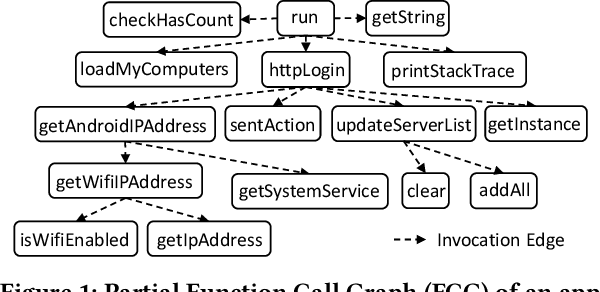
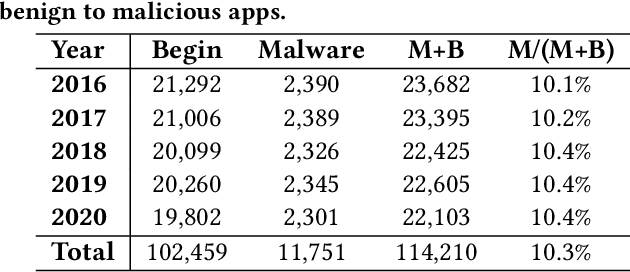
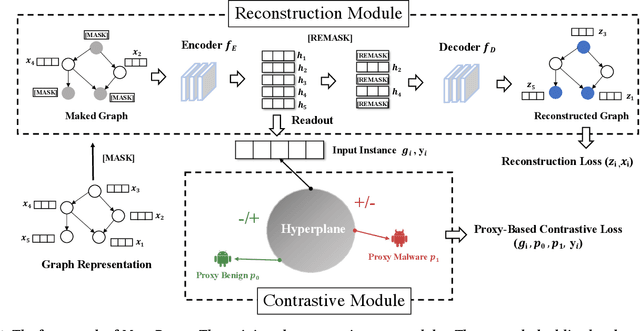
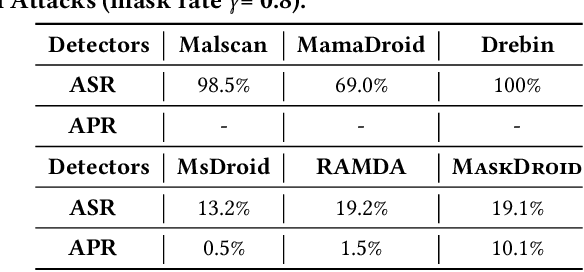
Abstract:Android malware attacks have posed a severe threat to mobile users, necessitating a significant demand for the automated detection system. Among the various tools employed in malware detection, graph representations (e.g., function call graphs) have played a pivotal role in characterizing the behaviors of Android apps. However, though achieving impressive performance in malware detection, current state-of-the-art graph-based malware detectors are vulnerable to adversarial examples. These adversarial examples are meticulously crafted by introducing specific perturbations to normal malicious inputs. To defend against adversarial attacks, existing defensive mechanisms are typically supplementary additions to detectors and exhibit significant limitations, often relying on prior knowledge of adversarial examples and failing to defend against unseen types of attacks effectively. In this paper, we propose MASKDROID, a powerful detector with a strong discriminative ability to identify malware and remarkable robustness against adversarial attacks. Specifically, we introduce a masking mechanism into the Graph Neural Network (GNN) based framework, forcing MASKDROID to recover the whole input graph using a small portion (e.g., 20%) of randomly selected nodes.This strategy enables the model to understand the malicious semantics and learn more stable representations, enhancing its robustness against adversarial attacks. While capturing stable malicious semantics in the form of dependencies inside the graph structures, we further employ a contrastive module to encourage MASKDROID to learn more compact representations for both the benign and malicious classes to boost its discriminative power in detecting malware from benign apps and adversarial examples.
Unraveling the Key of Machine Learning Solutions for Android Malware Detection
Feb 05, 2024
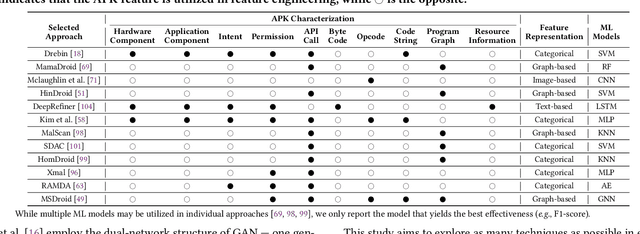


Abstract:Android malware detection serves as the front line against malicious apps. With the rapid advancement of machine learning (ML), ML-based Android malware detection has attracted increasing attention due to its capability of automatically capturing malicious patterns from Android APKs. These learning-driven methods have reported promising results in detecting malware. However, the absence of an in-depth analysis of current research progress makes it difficult to gain a holistic picture of the state of the art in this area. This paper presents a comprehensive investigation to date into ML-based Android malware detection with empirical and quantitative analysis. We first survey the literature, categorizing contributions into a taxonomy based on the Android feature engineering and ML modeling pipeline. Then, we design a general-propose framework for ML-based Android malware detection, re-implement 12 representative approaches from different research communities, and evaluate them from three primary dimensions, i.e., effectiveness, robustness, and efficiency. The evaluation reveals that ML-based approaches still face open challenges and provides insightful findings like more powerful ML models are not the silver bullet for designing better malware detectors. We further summarize our findings and put forth recommendations to guide future research.
Adversarial Neural Network Inversion via Auxiliary Knowledge Alignment
Feb 22, 2019



Abstract:The rise of deep learning technique has raised new privacy concerns about the training data and test data. In this work, we investigate the model inversion problem in the adversarial settings, where the adversary aims at inferring information about the target model's training data and test data from the model's prediction values. We develop a solution to train a second neural network that acts as the inverse of the target model to perform the inversion. The inversion model can be trained with black-box accesses to the target model. We propose two main techniques towards training the inversion model in the adversarial settings. First, we leverage the adversary's background knowledge to compose an auxiliary set to train the inversion model, which does not require access to the original training data. Second, we design a truncation-based technique to align the inversion model to enable effective inversion of the target model from partial predictions that the adversary obtains on victim user's data. We systematically evaluate our inversion approach in various machine learning tasks and model architectures on multiple image datasets. Our experimental results show that even with no full knowledge about the target model's training data, and with only partial prediction values, our inversion approach is still able to perform accurate inversion of the target model, and outperform previous approaches.
 Add to Chrome
Add to Chrome Add to Firefox
Add to Firefox Add to Edge
Add to Edge